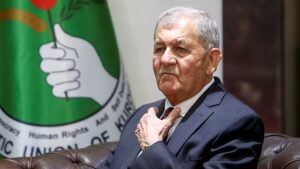
The mission of the International Monetary Fund (IMF), whose positive conclusions will start work on a new program with it, is expected to begin work in Ukraine next week, said the head of the National Bank of Ukraine, Andriy Pyshny.
“We expect the start of the IMF mission as early as next week. We hope to reach agreements on macroeconomic indicators, parameters of the state budget for 2023 and sources of covering its deficit, which will be the beginning of work on a new program with the Fund,” the press service of the National Bank quoted him as saying. .
Pyshny also thanked the IMF for providing $1.3 billion in additional emergency financing under the RFI instrument, which arrived in Ukraine on Thursday.
As reported, on the eve of the IMF Managing Director Kristalina Georgieva said that the Fund’s team, together with the Ukrainian team, immediately after the annual meeting of the IMF and the World Bank (WB) this week, will determine Ukraine’s macroeconomic framework and budget.
In addition, US Treasury Secretary Janet Yellen noted that a new full-fledged IMF program for Ukraine could be early next year.
Finance Minister Serhiy Marchenko said the government estimates the need to finance the state budget deficit in 2023 at $3.5 billion a month, compared to $5 billion a month in 2022, which Ukraine has so far failed to raise. The best indicator was August with $4.6 billion, and in general, since the beginning of the war, or almost eight months, external funding amounted to $20.7 billion, of which almost 50% were grant funds.
The draft state budget of Ukraine for 2023, which was adopted in the first reading, provides for external financing of the deficit in the amount of $38 billion, or about $3.2 billion per month.

American billionaire Elon Musk has unveiled the “Burnt Hair” perfume with the smell of burnt hair, which is sold on the website of his company Boring Co. priced at $100 per bottle.
Musk, who is the head of Tesla, changed his Twitter status to “Fragrance Seller” and wrote that he had already sold 10 thousand bottles of perfume, that is, a total of $ 1 million.
Earlier, the billionaire reported that Boring will introduce a men’s fragrance that will help a person “stand out from the crowd.” He joked on Twitter that it was inevitable for a man with his last name to enter the perfume business (Musk means “musk” in English).
“Why did I even resist this for so long?” he wrote.
Last week, Musk sent a letter to Twitter executives offering to complete the acquisition of the company for $44 billion, although he had previously refused this intention.
“Please buy my perfume so I can buy Twitter,” he wrote on his page on Wednesday.
The billionaire has repeatedly released playful products that his fans buy as collectibles. For example, in 2018, Boring Co., an underground tunneling company, produced 20,000 hand-held flamethrowers and raised $10 million to fund its operations.
He also offered his fans to buy Tesla-branded “short shorts” as a prank on traders who were “short” in the shares of the electric car maker. In addition, he produced tequila “Tesla”.

US dollar is stable against the euro, strengthening against the yen and the pound sterling on Friday.
The ICE-calculated index, which shows the dynamics of the dollar against six currencies (the euro, the Swiss franc, the yen, the Canadian dollar, the pound sterling and the Swedish krona), adds 0.03% during trading, the broader WSJ Dollar Index loses 0.02%.
The data of the US Department of Labor published the day before showed a weaker-than-expected slowdown in inflation. The CPI rose in September by 8.2% against the same month last year – the lowest rate in seven months. Experts polled by Trading Economics predicted, on average, a slowdown in inflation to 8.1% from 8.3% in August.
Meanwhile, core inflation, excluding the cost of food and energy (Core CPI) accelerated in September to the highest since August 1982 6.6% in annual terms from 6.3% a month earlier.
Published statistical data have strengthened investors in the opinion that the Federal Reserve System (Fed) will continue the rapid tightening of monetary policy. Now traders are waiting for a sharp rise in the rate of the US Central Bank at each of the two remaining meetings of this year, Bloomberg notes.
The euro/dollar pair is trading at $0.9781 compared to $0.9780 at the close of the previous session.
The US currency against the yen is 147.45 yen against 147.22 yen at the close of the market on Thursday.
The pound fell to $1.1322 from $1.1331 the day before.
British Treasury Secretary Kwazi Kwarteng left Washington, where he was meeting with representatives of the International Monetary Fund (IMF), a day earlier than planned. Experts believe that he may abandon part of the tax cuts he announced earlier in order to prevent an economic crisis in the country, the Financial Times writes.
The newspaper’s sources note that the IMF and finance ministers of several other countries recommended that he quickly abandon plans for tax cuts in order to avoid financial problems in the economy.

PJSC Interpipe Nyzhniodniprovsky Pipe Rolling Plant (NTZ, Dnipro) in January-June of this year posted a net loss of UAH 882.682 million against a net profit of UAH 163.581 million for the same period last year.
According to the interim report of the company, net income for this period decreased by 42.8% – to UAH 4.176 billion.
Retained earnings by the end of June 2022 amounted to UAH 2.951 billion.
In turn, the consolidated loss of Interpipe NTZ for January-June 2022 amounted to UAH 882.732 million (there was a profit of UAH 163.481 million).
According to the annual report for 2021, the company’s net loss amounted to UAH 486.412 million against a net profit of UAH 22.905 million for 2020. Income for 2021 amounted to UAH 8.226 billion (for 2020 – UAH 9.470 billion).
The group also published a report for January-March 2022, according to which the loss amounted to UAH 783.259 million, net income – UAH 1.075 billion.

The Estonian volunteer rescue association Paasteliit on Thursday handed over 10 mobile houses Containex as humanitarian aid to the State Emergency Service of Ukraine.
According to the press service of the Main Directorate of the State Emergency Service of Ukraine in Lviv region, these containers are adapted for living, each of them has a living and shower room, as well as a toilet. Heat is generated by air-type heat pumps.
“We are grateful to our colleagues for this valuable gift, as a long winter awaits us ahead, and, unfortunately, there are more than 7 million internally displaced persons in Ukraine and millions more living in territories where the enemy can destroy their homes at any moment. Thus, Ukrainian rescuers will be able to provide temporary warmth and shelter in the most critical areas,” the message says.

Latif Rashid on Thursday became the President of Iraq following a vote in Parliament, which marked the beginning of the formation of the Iraqi government – a year after the parliamentary elections in the country, Rudaw reports.
Rashid beat his opponent, former Iraqi President Barham Saleh, by 63 votes. In total, 162 deputies voted for Rashid.
Mohammed al-Sudani, who is running for the new prime minister, is expected to form a government within 30 days.
Previously, Rashid served as the Minister of Water Resources of Iraq, and was also a representative of the Patriotic Union of Kurdistan party.
Protests against corruption in Iraq caused early parliamentary elections in the country in October 2021. However, elected parliamentarians could not form a government due to disagreements between political blocs over the mechanisms for its formation.